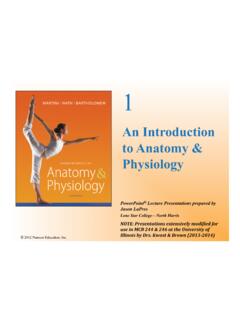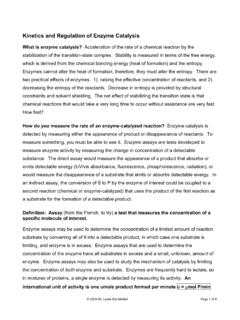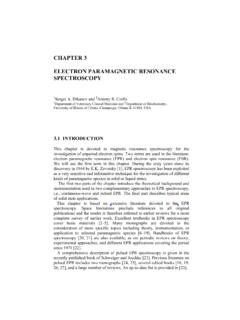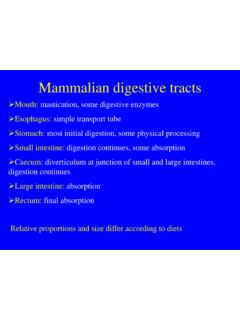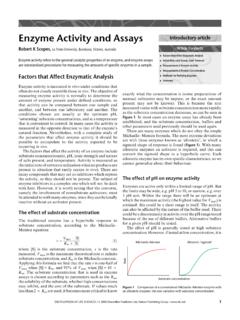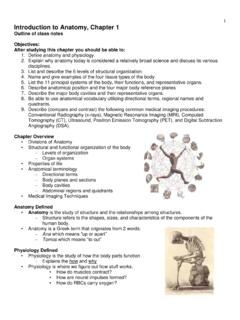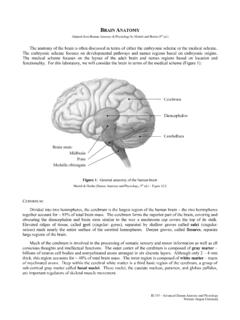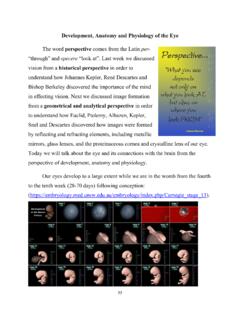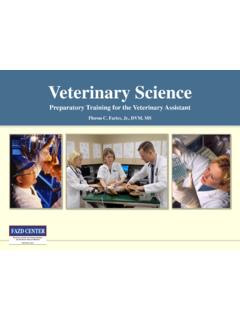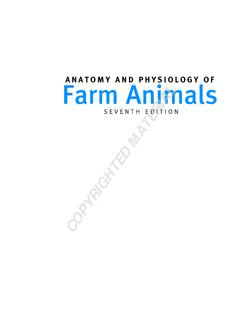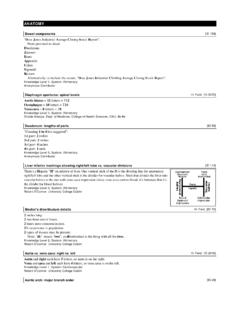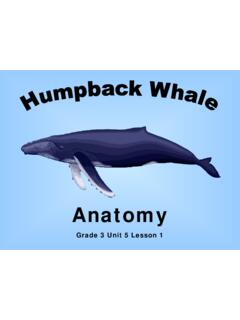Transcription of External Anatomy - University of Illinois Urbana-Champaign
1 External AnatomyGeneral TopographyAny description of External characteristics of birds generally usessome specialized terminology for particular regions, feathers, of these is especially important for identification yourself with the topographic features illustrated inyour field guide and in the figures provided in this handout. Payspecial attention to the names set in italics. Locate these features onseveral specimens to see how they of these features are self-evident, but familiarize yourself withthe terminology (Figure 1).Throat. The throat is the ventral region extending from just underand below the lower mandible to the anterior margins of the The nape refers to the dorsal surface of the neck extendingfrom the mid back of the skull to the beginning of the thoracic The back is roughly the area between the The rump overlies the pelvic bones anterior to the tail andis bounded by the The breast extends over the breast musculature nearly tothe posterior end of the or belly.
2 The abdomen extends from the posteriorsternum to the feathers. The crural feathers cover the tibial portion ofthe leg and are continuous with the feathers of the abdomen. Insome species ( the Rough-legged Hawk, family Accipitridae)these feathers extend all the way to the top of the The side extends from the abdominal region up to the base ofthe region. The base of the underside of the wing, extend-ing to the ventral wing The lateral area posterior to the side, extending back to thebase of the familiar with the following terminology, especially for thoseregions of the head that serve as frequent field marks (Figure 2).
3 Forehead. The forehead extends from the base of the uppermandible to a line drawn across the top of head approximatelyover the middle of the The crown extends from just posterior to the forehead tothe beginning of the cervical vertebrae of the The lore is the lateral area of the head between the front ofthe eyes and the base of the and superciliary line. The supercilium is a line offeathers immediately above the eye. It is distinctly colored in manybirds (especially sparrows, family Emberizidae) and is called thesuperciliary ring. The eye ring is a group of feathers surrounding the eyeat the edge of the eyelids.
4 These feathers often contrast with thoseimmediately surrounding them, forming a distinct eye ring thatcan be a useful field The eyeline extends back along the side of the head fromthe posterior angle of the eye. Another potentially useful feathers. Narial feathers are dense, stiff feathers thatextend forward along the upper mandible to partially cover theExternal Anatomy1 Ear covertsCrownForeheadLoreChinThroatLesser covertsMedian covertsAlulaBreastSideBellyGreater primary covertsThigh (crural feathers)FlankVentPrimariesUndertail covertsUppertail covertsRumpSecondariesLower backTertialsScapularsUpper backGreater covertsNapeSide of neckFigure 1.
5 General These feathers are particularly evident on the crows (fam-ily Corvidae).Auriculars or ear coverts. The auriculars are a patch of feath-ers just behind and below the eye that cover the External ear. Theyare often loosely region or mustache feathers. The malar feathers liebetween the eye and the throat, extending back from a point wherethe upper and lower jaw meet (the commisure). They are distincton the male Northern Flicker (family Picidae).BillThe overall size and shape of the bill can be useful for identifica-tion and can indicate general foraging ecology. For instance, seed-eating birds tend to have heavy, conical bills (sparrows, familyEmberizidae), insect-gleaning birds have slender, sharply pointedbills (warblers, family Parulidae), sallying birds tend to have broad,flattened bills (flycatchers, family Tyrannidae), aerial insectivoreshave small External bills with a large gape (nightjars, familyCaprimulgidae), and piscivorous birds tend to have long, heavy,sharply pointed bills (loons, family Gaviidae).
6 Note: a decurved billcurves downward (Brown Creeper, family Certhiidae), while arecurved bill curves upward (stilts, family Recurvirostridae). Wewill cover foraging ecology and function morphology in moredetail during the BOW The External nostrils are located on the top of the shape of the nostril occasionally serves as a taxonomic charac-ter. For example, albatrosses and other members of the orderProcellariiformes have tubular nostrils that extend down the bill(and are associated with salt glands that remove salt from seawater)while superficially similar gulls (family Laridae) have linear nos-trils. Accipiter hawks (family Accipitridae) have oval nostrils, whilefalcons (family Falconidae) have circular The operculum is a soft, fleshy structure at the baseof the upper bill that covers the External nostrils.
7 It is especially evi-dent in pigeons (family Columbidae).To m i a. The tomia (singular, tomium) is the cutting edges of eitherthe upper or lower mandible. The tomia are notched in some birds(falcons, family Falconidae), and serrate in others (mergansers,family Anatidae).WingLocate the following features on the illustrations (Figures 3 and 4)and on the spread wings or the study skins, but please don t try toopen the folded wings of the study skins. Although some termsrelated to the skeletal structure of the wing are introduced here, wewill cover the them in greater detail during the internal The flight feathers are collectively called remiges (singu-lar, remex) and attach to the bones of the wing.
8 These long, stifffeathers fall into two major groups, the primaries and the second-aries, based on their point of SparrowSharp-shined HawkMedian crown stripeCrown stripeSuperciliary stripeEye ringAuricularsMalar regionChinRictal bristlesMandibleForeheadNostrilMaxilaLor eTomial notchOperculumRictal bristlesSupraorbital ridgeNapeCrownCommisureFigure 2. Topography of the Primary1st Primary1st SecondaryUlnaManusPollexFigure 3. Ventral surface of the covertsMedian secondary covertsGreater secondary covertsLesser secondary covertsGreater primary coverts10th primary remexAlular quillsAlular quill covertsTertialsFigure 4. Dorsal surface of the The primaries attach to the bones of the hand (themanus) and are numbered from the innermost one outward.
9 Theyprovide the main propulsive force of the outer wing during pow-ered flight, and are strongly asymmetrical (compare them to thesecondaries), each acting as an individual airfoil. Most birds haveeleven primaries (the eleventh, the remicle is often rudimentary ormissing), but Ostriches have sixteen, a small number of groupshave twelve, and many passerines (songbirds) have The secondaries attach to the trailing edge of theulna and are numbered from the outside in. They form the trailingedge of the wing s airfoil. The surface area of the wings of largesoaring birds consists mostly of secondaries. The number of sec-ondaries in the wing varies with wing length, ranging from nine inmost passerines to twenty-five in the larger The alula, a group of three small, stiff feathers (the alularquills), arises from the first digit (or pollex) of the hand.
10 The alulaacts as a aerodynamic slot, controlling the flow of air over the wingduring The tertiaries are a group of three or four feathers justproximal to the innermost The scapulars arise from the shoulder and overly thescapula (shoulder blades) at the base of the dorsal wing. Thesefeathers often cover much of the folded wing on a perched The axillaries are the ventral counterpart of thescapulars, and are found on the ventral base of the wing (in the armpit ). In many species these feathers are pale, but in a few ( Black-bellied Plover, family Charadriidae) they are dark andserve as a good field mark for a bird in Coverts.
